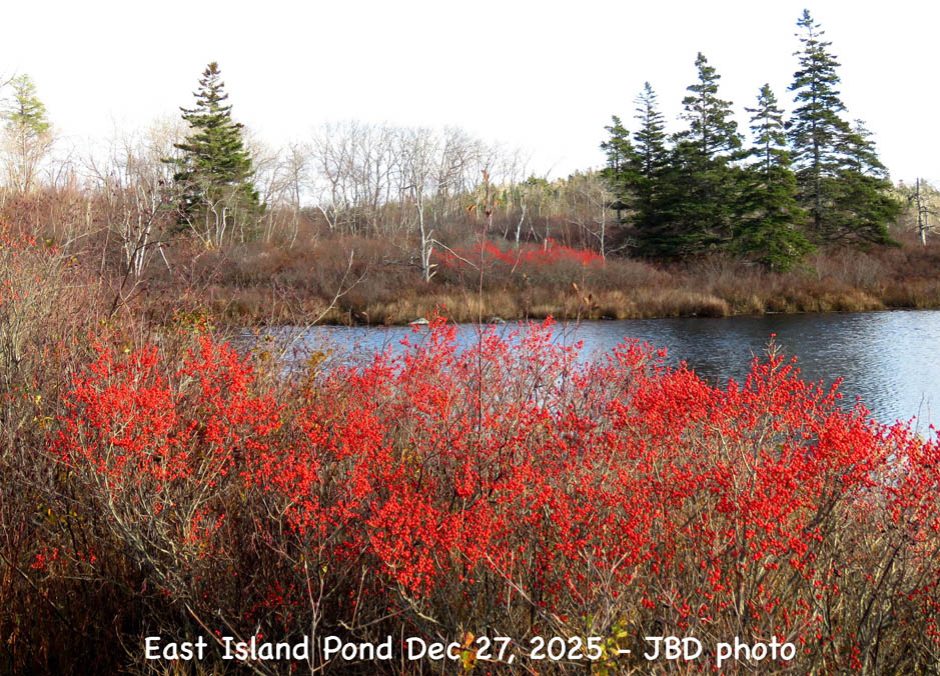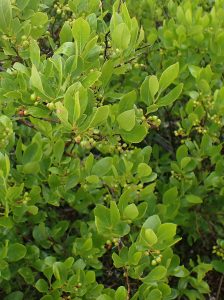The mystery pest appears to be the work of a fungus in the genus Exobasidium, a group of parasitic fungi. While berry production in the area examined will certainly be reduced this year, it probably won’t have serious longer term impacts. The outbreak may be related to the unusually wet weather over last few weeks. With a little citizen science/use of iNaturalist, we can track its occurrence in the Backlands.
UPDATE July 4, 2023. Already a report has come in that the mystery pest is abundant on black huckleberry to the south and southwest of Osprey Trail area. See comment.
By David Patriquin
In a nutshell: most of the Black Huckleberry (Gaylusaccia bacatta) plants I looked at yesterday (July 2), between downpours, within 300 m or so of the trailhead for the Osprey Trail were heavily infected by a mystery pest that causes pinkish galls to form on leaves and distorts fruit (berry) development of black huckleberry (Gaylussacia baccata). I found very few plants with normal berries.
Visually, these structures and deformations look very much like the work of a fungus in the genus Exobasidium, a group of parasitic fungi* so that’s a tentative ID; confirmation by experts is still required to confirm it as such and identify it to the species level.
Many species of Exobasidium are pathogens on plants of the heath family (Ericaceae). Heath family species are prominent on the whaleback outcrops and associated low areas of the McIntosh Run barrens. Besides the huckleberries, blueberries, leatherleaf, sheep laurel (lambkill), crowberries, bearberry, foxberry and teaberry are members of the Heath family; so are our garden rhododendrons and azaleas.
* This possible ID was suggested to me by Sean Basquill, Ecosystem Scientist with Nova Scotia NRR.
Huckleberry is amongst, if not the most, abundant shrub on the McIntosh Run barrens. It produces delicious berries in late summer but, at least in this particular area, there wont be many this year. It’s also the shrub that turns fire engine red and gives us the spectacular vistas in October; I don’t expect that will change,
So far this year, I haven’t noticed the mystery pest on huckleberry in other areas of the Backlands where I have been recently (Piggy Mt., Shaw Wilderness Park, Pine Island Ponds) but with all of our very wet weather, it could be developing rapidly.
I didn’t observe the mystery pest on lowbush blueberries or any other heath family species including some Northern Dwarf Huckleberry plants (Gaylusaccia bigelovonia; syn. G. dumosa) observed at a few locales – it was in full flower at the time. (If the mystery pest infected lowbush blueberries that could be a huge economic concern for Nova Scotia.)
If you spot the mystery pest (or something that looks like it) and are familiar with iNaturalist, please make a post and suggest the name Exobasidium – then the record will show up on the iNaturalist map for Exobasidium right away (see July 3 version below). I am making a post about it all now rather than waiting till we know more about it so that we might get some info. about it early on and when it is still quite distinctive.

Records of Exobasidium in the Backlands on iNaturalist. From iNaturalist map for Exobasidium. The asterisks are records I posted; they are intended to be representative of the area I examined, not of all of the occurrences which would be very many. Example. There are currently two other reports of Exobasidium in the Backlands, both fairly close by to the Osprey Trail.
Click on image for larger version.
Likewise, it would be helpful to post photos on iNaturalist of uninfected Black Huckleberry in the Backlands for some representative sites within areas visited. Such observations will be listed here (under an iNaturalist Project for the Backlands).
Aside from losing most of this year’s crop of Huckleberries – not a small deal to huckleberry aficionados – I don’t think there is anything particularly ominous about this pest. Assuming it is a species of Exobasidium, it’s a native pest that is not known to be highly detrimental over a longer period, at least not to wild-growing populations.
I suspect (hypothesize) that the current outbreak in the McIntosh Run barrens is related to the excessively moist weather of the past few weeks, perhaps combined with the warm spell late into January and stresses associated with the “Polar Vortex“. (Thx S.A.)
The mystery pest may be particularly pronounced in the area of the whaleback barrens because of the high density of the bushy vegetation and because the whalebacks act as water collectors for the low areas, i.e. they can get wet very quickly and on the granite foundation, they tend to hold the water. Moist conditions are very conducive to fungal growth.
There is some evidence that pests and diseases are increasing more generally because of stresses associated with climate change, so perhaps this outbreak is the first of more to come. Or not. Because this disease – whatever it is – is very distinctive, with a little citizen science/use of iNaturalist to record observations, it seems to offer an opportunity to gain some insight into how our Backlands are responding to complex changes in our environment.
Links
Osprey Trail: pine barrens & whalebacks
Page on this website
Exobasidium
On Wikipedia with links to species including Exobasidium vaccinii. “Exobasidium vaccinii, commonly known as “red leaf disease,” or “Azalea Gall,” is a biotrophic species of fungus that causes galls on ericaceous plant species, such as blueberry and azalea (Vaccinium and Rhododendron spp.). Exobasidium vaccinii is considered the type species of the Exobasidium genus.”
Field Manual of Diseases on Trees and Shrubs
R. Kenneth Horst. 2013. Springer, Dordrecht. https://doi.org/10.1007/978-94-007-5980-0_9. Page 98, under Huckleberry: “Gall, Leaf. Exobasidium vaccinii, ME to VA, AL, FL, WI; Synchytrium vaccinii, red lead, NJ.” Its also listed under Blueberry (Vaccinium)
“Ghost’s Ears” (Exobasidium sp. affin. vaccinii) and Fool’s huckleberries (Menziesia ferruginea smith): a Unique report of mycophagy on the central and north coasts of British Columbia
Brian Compton, 1995. J. Ethnobiol. 15(1):89-98. The galls produced by Exobasidium vaccinii on Menziesia ferruginea (false azalea) in the Pacific Northwest are consumed by and have spiritual significance for the Heiltsuk indigenous people in Central BC.
COMMENTS
July 4, 2023: After making this post I received an e-mail from JBD who commented that on Saturday (July 1) he was in the field and comments: “I saw “the thing’ on the black huckleberry just about everywhere I went. [It’s] All along the trail to the Look off at Princeton Ave, along the trail to the spot where the Macintosh Run drops down and becomes the lower run (the spillway), out at East Pine Island Pond to the left of the Pump House Road in the direction of Lower Mud Pond and Powers Pond, and also all along the trail to the swimming spot at EPIP”. Joshua says will go back and get a few pics to put on iNaturalist. Many Thx JBD!. KM had posted a photo of a deformed fruit on huckleberry in the Pine Island Ponds area (June 18, 2023) that looks like Exobasidium. View iNaturalist Record



